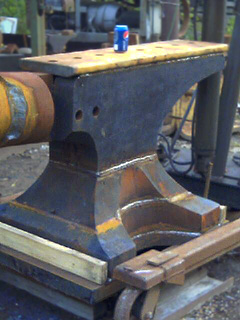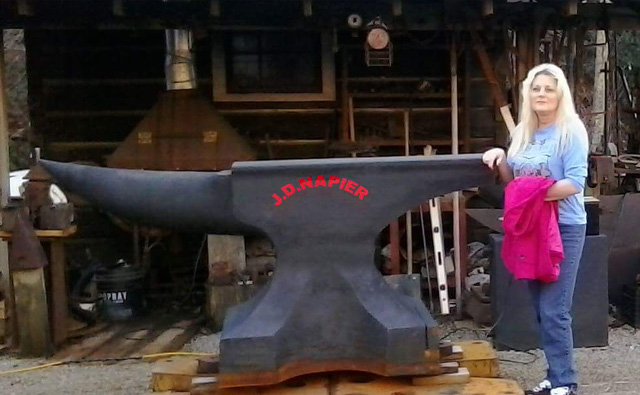This is the result of a 25 year dream and 15 year project starting with collecting materials.
It was JD's dream and he was the driving force to keep it going.
JD's anvil was brought to our attention by Marcus Walters who did most of the cutting using an oxy-acetylene torch on plate up to 10" thick!
Without Marcus' skill I doubt that this project would have been completed.
There are very few who can maually cut such plate by hand and have it smooth and accurate enough to be useful.
Those of you that have used a cutting torch on heavy plate know just how difficult this is.
When I need plate cut accurately I rig up a machine torch on a lathe OR use a Hob-O Circle cutter.
However, my machine torch is only rated for 6" plate!
 The work on this anvil was done by a number of welders.
Most of the joints are only sufficient to hold the anvil together.
But I am also sure there is a great deal of heavy weld fill that was ground smooth to correct the lines of the anvil.
Some welders worked a few days on the anvil, others worked weeks.
The work on this anvil was done by a number of welders.
Most of the joints are only sufficient to hold the anvil together.
But I am also sure there is a great deal of heavy weld fill that was ground smooth to correct the lines of the anvil.
Some welders worked a few days on the anvil, others worked weeks.
THE WELDERS:
Markus Walters
Larry Shelpherd
Mac Brock
Michael Middleton
Logan Lewis
Ryan Patterson
Anthony Brown
Fred Loving (knife maker and woodworker)
The horn, is tennoned and pinned prior to welding so it is quite stoutly affixed.
A huge forge was built using a tractor wheel to heat the horn and forge its curve.
The fire was so hot that it burned out the tractor wheel!

Ruby Walters wife of Marcus Walters with anvil.
SIZE:
6500 pounds, 58 Hundredweight, 3.1 Long Tons, 2948 K)
Length: 82" (6 ft, 10"), 208 cm.
Face Plate: 13 x 48 x 1.75" (33 x 122 x 4.5 cm)
Body Thickness: 12" (30.5 cm)
Base/Foot: 38 x 32 x 9 (97 x 81 x 23 cm)
Body at Base: 18" (46 cm)
Hardy Hole: 2.25" (57mm)

Jordan Cartwright from Calgary, Canada with JD Napier next to THE anvil. . .


JD with tipped up Anvil.
Anvil parts stacked and ready to weld. (Click for larger)

- * Largest Anvil
- The fact is there ARE larger anvil sculptures in bronze and stone.
But our category is for "solid steel (cast or fabricated) blacksmith anvils by weight".
One could say a "real" anvil but this not a tool to forge on, it is more sculpture than tool.
You COULD, but not to the capacity requiring 3 tons of anvil. . .
SO. . this leaves us in a definitions quandary. It is either a sculpture OR its a tool (albeit oversize).
As a sculpture it could be made of wood, stone, metal, be hollow OR solid.
As a tool it would have to be sufficiently solid steel with high percentage welds and have a solid heat treated face
(edge welding not accepted).
The largest anvil sculptures we have found are by Barry Flanagan (Welsh, 1941-2009).
His smaller works had large shop sized anvils with whimsical hares dancing on the horn.
Several later versions have an anvil of roughly 20 feet in length and perfectly proportioned.
One, titled "Large Nijinski on Anvil Point"
has the anvil tilted back on its heel has one of his hares dancing on the tip of the upturned horn.
One of more of his sculptures using the same anvil have a full sized horse standing on the face.
Even a hollow bronze casting this size will weigh roughly the same as the solid steel anvil above.
Look out Wiley E. Coyote!

Grandchildren on the Anvil
"I thought Granpa was building a Rocket ride!"




 Ray Davis' "Mile Long Anvil"
Ray Davis' "Mile Long Anvil"

This is the result of a 25 year dream and 15 year project starting with collecting materials. It was JD's dream and he was the driving force to keep it going.
JD's anvil was brought to our attention by Marcus Walters who did most of the cutting using an oxy-acetylene torch on plate up to 10" thick! Without Marcus' skill I doubt that this project would have been completed. There are very few who can maually cut such plate by hand and have it smooth and accurate enough to be useful. Those of you that have used a cutting torch on heavy plate know just how difficult this is. When I need plate cut accurately I rig up a machine torch on a lathe OR use a Hob-O Circle cutter. However, my machine torch is only rated for 6" plate!
THE WELDERS:
Markus Walters
Larry Shelpherd
Mac Brock
Michael Middleton
Logan Lewis
Ryan Patterson
Anthony Brown
Fred Loving (knife maker and woodworker)
The horn, is tennoned and pinned prior to welding so it is quite stoutly affixed. A huge forge was built using a tractor wheel to heat the horn and forge its curve. The fire was so hot that it burned out the tractor wheel!
Ruby Walters wife of Marcus Walters with anvil.
6500 pounds, 58 Hundredweight, 3.1 Long Tons, 2948 K)
Length: 82" (6 ft, 10"), 208 cm.
Face Plate: 13 x 48 x 1.75" (33 x 122 x 4.5 cm)
Body Thickness: 12" (30.5 cm)
Base/Foot: 38 x 32 x 9 (97 x 81 x 23 cm)
Body at Base: 18" (46 cm)
Hardy Hole: 2.25" (57mm)
Jordan Cartwright from Calgary, Canada with JD Napier next to THE anvil. . .
SO. . this leaves us in a definitions quandary. It is either a sculpture OR its a tool (albeit oversize). As a sculpture it could be made of wood, stone, metal, be hollow OR solid. As a tool it would have to be sufficiently solid steel with high percentage welds and have a solid heat treated face (edge welding not accepted).
The largest anvil sculptures we have found are by Barry Flanagan (Welsh, 1941-2009). His smaller works had large shop sized anvils with whimsical hares dancing on the horn. Several later versions have an anvil of roughly 20 feet in length and perfectly proportioned. One, titled "Large Nijinski on Anvil Point" has the anvil tilted back on its heel has one of his hares dancing on the tip of the upturned horn. One of more of his sculptures using the same anvil have a full sized horse standing on the face. Even a hollow bronze casting this size will weigh roughly the same as the solid steel anvil above.
Look out Wiley E. Coyote!
Grandchildren on the Anvil
"I thought Granpa was building a Rocket ride!"